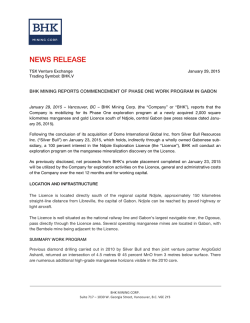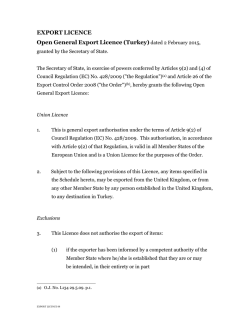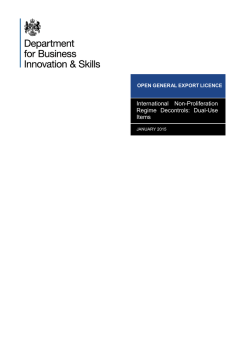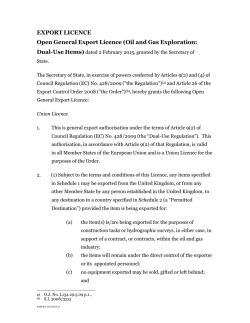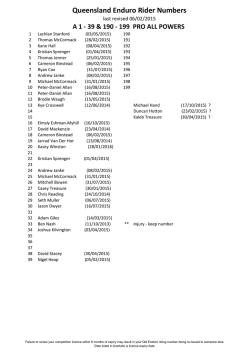
Decision - Utility Regulator
` Aggregated Generator Units (AGU) & Demand Side Units (DSU) Licensing Arrangements Decision Paper 30 January 2015 About the Utility Regulator The Utility Regulator is the independent non-ministerial government department responsible for regulating Northern Ireland’s electricity, gas, water and sewerage industries, to promote the short and long-term interests of consumers. We are not a policy-making department of government, but we make sure that the energy and water utility industries in Northern Ireland are regulated and developed within ministerial policy as set out in our statutory duties. We are governed by a Board of Directors and are accountable to the Northern Ireland Assembly through financial and annual reporting obligations. We are based at Queens House in the centre of Belfast. The Chief Executive leads a management team of directors representing each of the key functional areas in the organisation: Corporate Affairs; Electricity; Gas; Retail and Social; and Water. The staff team includes economists, engineers, accountants, utility specialists, legal advisors and administration professionals. Our Mission Value and sustainability in energy and water. Our Vision We will make a difference for consumers by listening, innovating and leading. Our Values Be a best practice regulator: transparent, consistent, proportional, accountable, and targeted. Be a united team. Be collaborative and co-operative. Be professional. Listen and explain. Make a difference. Act with integrity. Abstract The Utility Regulator seeks to introduce a sustainable licensing solution which will support Aggregated Generation Units (AGU) and Demand Side Units (DSU) to participate within the wholesale market. A consultation paper discussed the proposed AGU and DSU licences and considered the transition of AGU operators currently holding Regulatory Agreements to the modified licences. The purpose of licensing AGUs and DSUs is to ensure that they are treated on a nondiscriminatory and transparent basis. This will help ensure that their rights within the wholesale market are the same as those who are currently required to hold a licence to operate. This paper details the Utility Regulator’s final decision in respect of the proposed licensing arrangements to issue modified generation licences to both AGUs and DSUs in Northern Ireland. Audience Electricity Industry, Business Community, Statutory Bodies Consumer impact New licences for participants wishing to register Aggregated Generation Units and Demand Side Units in Northern Ireland should help facilitate increased competition and security of supply in the electricity market. 1 1. 2. 3. 4. 5. 6. Introduction Background Consultation Responses Points Raised by Respondents Utility Regulator Proposed Decision Next Steps 3 3 5 6 11 18 2 1. Introduction 1.1. Aggregated Generator Units (AGUs) and Demand Side Units (DSUs) require regulatory approval to operate in the Single Electricity Market (SEM). At present this is granted to AGUs through a Regulatory Agreement, but there is no mechanism to allow DSUs to operate in Northern Ireland. 1.2. The Utility Regulator seeks to introduce a sustainable licensing solution which will support both Aggregated Generation Units (AGU) and Demand Side Units (DSU) to participate within the wholesale market. The purpose of licensing AGUs and DSUs is to ensure that they are treated on a nondiscriminatory and transparent basis. This will help ensure that their rights within the wholesale market are the same as those who are currently required to hold a licence to operate. This paper is structured into the following sections: Introduction; Background - this chapter provides background to this decision paper; Consultation Responses – this section gives information on the consultation process and on the respondents to the consultation; Points Raised by Respondents – this portion of the paper discusses the issues raised by respondents to the consultation; Utility Regulator Decision – this section explains the decision taken by the UR in relation to the issues raised through the consultation process; and Next Steps – this chapter outlines the next steps for implementation of this decision. 2. Background 2.1. The SEM Committee published a decision paper on the Aggregated Generator Units in the SEM’1 (SEM-08-178) Committee Decision for the Regulatory Authorities in Mod_36_10 (Removal of connection between Supplier Units ‘Inclusion of and a SEM relation to and DSUs) 2. 1 http://www.allislandproject.org/GetAttachment.aspx?id=66925151-d8ae-4933-89d2-0feb07143f10 http://www.semo.com/MarketDevelopment/ModificationDocuments/120403%20SEM%20C%20Decision%20on%20Mod%2036_10.pdf 2 3 These papers were undertaken due to the potential benefits of having Aggregated Generation Units (AGU) and Demand Side Units (DSU) operating within the Single Electricity Market (SEM). The SEM Committee decision required potential AGU and DSU registrants to obtain the approval of the regulator in each jurisdiction in which they wished to operate. For Northern Ireland (NI) the UR put in place AGU Regulatory Agreements recognising ‘this is not a perfect long term solution and is intended as a short term remedy to the problem of AGU compliance’. 2.2. An interim solution was put in place for Generator Aggregators utilising a set of Regulatory Agreements in line with the SEM Decision Paper (SEM08-178). A key purpose of the agreement was to require the Generator Aggregator to comply with provisions on cost reflective bidding in the SEM. This solution was intended to be short term while licensing provisions were being established. While it attempts to replicate the responsibility of licence holder, it cannot by its nature fully replicate a licence. 2.3. Recognising the need to place arrangements for DSUs and AGUs on a more sustainable foundation, the UR proposed the use of a modified electricity generation licence. In August 2014, the UR consulted upon both this proposal along with two draft licences applicable to registrants of a DSU and AGU respectively. The draft licences are intended to contain conditions which are suitable for regulating the operation of AGUs and DSUs while facilitating the promotion of non-discriminatory and transparent treatment of all those wishing to participate in the SEM. 2.4. The main purpose of this paper is to summarise the responses to the Consultation paper ‘Aggregated Generator Units (AGU) & Demand Side Units (DSU) Licensing Arrangements’, to outline the UR’s response to the issues raised in those submissions, and explain the UR’s proposed decision on the consultation and associated licensing documents. 4 3. Consultation Responses 3.1. The UR public consultation was an open consultation. No specific questions were posed within the documentation. Instead, stakeholders were invited to express views on any particular aspect of the paper or on the attached draft Licences for a Generator Aggregator and a Dispatchable Demand Customer. 3.2. We received 12 non-confidential responses from the following companies and organisations: Activation Energy AJ Power CBI Northern Ireland The Consumer Council Dalkia Alternative Energy Demand Response Aggregators of Ireland Electric Ireland iPower Manufacturing Northern Ireland Northern Ireland Electricity Powerhouse Generation Limited SONI 3.3. One other respondent wished for their response to be confidential and is not included in the above list. All non-confidential responses to the consultation have been published on the UR’s website.3 3.4. The following section explores the issues raised by respondents in their submissions on the consultation paper. 3 http://www.uregni.gov.uk/publications/reponses_to_agu_dsu_consultation 5 4. Points Raised by Respondents Licence proposal 4.1. The UR received no responses that opposed the principle of introducing AGU and DSU licences. Ten respondents expressed sentiments that were broadly favourable towards the proposed modified licences. One respondent SONI welcomed the description of the legal vires available to the UR to grant licences and expressed trust that the description had been verified appropriately. One respondent questioned the UR’s legal ability to issue aggregator (referring to both aggregation and demand side response) licences. 4.2. There appeared to be something of a consensus towards timely execution of the licensing arrangements. Four respondents expressed dismay at the period of time that it had taken for the consultation on DSU and AGU licences to occur with several of them noting the timelines in the UR’s Forward Work Plan for 2014-154. Six submissions requested that the licences be implemented as soon as practicable. Licence procedure 4.3. Seven respondents commented on the procedures surrounding implementation of the licences. Activation Energy expressed concerns over a risk of there being delays in the Distribution Network Operator (DNO) processing certain types of DSU activities, for example if the DSUs were to require changes to the connection agreement such as the Maximum Export Capacity (MEC). CBI Northern Ireland proposed that operators who have entered into existing Regulatory Agreements should not be prevented from continuing to facilitate demand side participation whilst the new licensing arrangements are being finalised. Dalkia Alternative Energy suggested that SONI, SEMO and NIE should engage with AGU and DSU operators during the consultation process so as to reduce the overall time taken to process an AGU/DSU application. Electric Ireland asked for greater clarification of the processes by which the licence proposals are activated, especially around the necessary approvals and timelines. They expressed an expectation that a generator 4 http://www.uregni.gov.uk/publications/utility_regulator_publishes_its_forward_work_programme_201415 6 aggregator application would vary from a demand reduction applicant, as for a demand reduction site no additional network capacity would be needed and thus they assert the DNO would not need to evaluate the impact on the network. Another submission requested the ability for AGU licensees to swiftly transfer to DSU licences if preferred, rather than being obligated to remain an AGU. Manufacturing Northern Ireland stated that the new licences should be issued immediately post decision to existing applicants and promptly to new applicants. They also maintained that the UR should ensure that NIE, SONI and SEMO facilitate demand side participation by undertaking their processes efficiently and in a timely manner. They claimed that these companies would not need to await the finalisation of the licensing arrangements as their internal processes are not dependent on the UR’s decision. Similarly, Powerhouse Generation Limited argued that a pre-existing DSU applicant or AGU Agreement holder should not have to make a fresh application, given the additional time, resources and cost involved for both the applicant and the UR. They also suggested that licences and consents should immediately be granted following the final decision on licensing arrangements with the Regulatory Agreements then being terminated. 4.4. AJ Power suggested that bureaucracy associated with the application processes involved should be reflective of the scale (in terms of capacity) of the applicant. 4.5. iPower maintained that careful consideration should be given to apportioning fees for either an AGU or DSU. They claimed that the overhead per MW is greater than for conventional generators due to the heterogeneous nature of the sites comprising an aggregation business (either as an AGU or a DSU). They proposed the licence fee for an aggregation business should be reduced to reflect this concern. Licence Definitions 4.6. SONI expressed concerns regarding the reliance within the licences upon the Grid Code for definitions of key terms. They argued that this dependency creates an additional responsibility for the Grid Code Review Panel as modifications of these terms would also constitute licence modifications, creating a linkage between two distinct legal frameworks. SONI requested that this situation is reviewed and that the UR further considers inserting the current definitions into the licences. 7 4.7. Two respondents challenged the definition of the term Dispatchable Demand Customer (DDC). Activation Energy argued that as a result of a 2013 SONI modification proposal, the term may no longer be defined within the Grid Code. They also queried as to whether references to DDCs would be appropriate for an Aggregated Demand Side Unit and if so then all references should be changed to DSU. iPower argued that the terminology of Demand Side Unit Aggregator would be more appropriate and intuitive than DDC, and suggested that a minor change to the Grid Code would be required. They considered DDC to be a counter intuitive term for a role that would be better summarised as a DSU aggregator or operator. Concerns regarding unequal treatment of participants 4.8. SONI opined that without a requirement for DSUs and AGUs to participate in TUOS Agreements and Interface Agreements (or equivalent); it is possible that market participants would not be subject to equal incentives. In effect, they expressed concerns that DSUs and AGUs would not face the negative consequences of failing to comply with the Grid Code and with dispatch instructions, similarly to other generators. For example, market participants are required to enter into a TUOS Agreement which provides SONI with a right to levy charges for non-compliance. SONI argued that a TUOS Agreement would be necessary to permit demand side and aggregator units to provide ancillary services under the Harmonised Ancillary Services (HAS) framework. They maintained that a 50MW AGU or DSU failing to comply with a dispatch instruction or Grid Code provision would have a similar impact upon system operation as a 50MW generator not doing so. 4.9. SONI referred to DSO concerns regarding a scenario in which individual demand sites acting in unison to reduce demand could lead to overloading and voltage issues on the distribution network, especially when a number of individual demand sites were connected to a particular bulk supply point. SONI presented a scenario where a DSU is available to the market and receiving capacity payments but could not be dispatched, as the relevant DSO associated with the bulk supply point had informed the TSO that there may be issues with such a dispatch for the distribution system. The submission appears to suggest that interface agreements between the TSO and the AGUs and DSUs would help mitigate this situation and that the consenting regime should oblige the DSU or AGU to enter into such arrangements. SONI also stated that Condition 4 of the proposed 8 licences should also include the Distribution Code within the provisions of its paragraph 3. Supply Licence 4.10. Powerhouse Generation Limited highlighted an issue that they were concerned had been overlooked in the development of the licences. They argued that in SEM, DSUs are required to have a Trading Site Supplier Unit (TSSU) and that an AGU must also have an Associated Supplier Unit (ASU). According to the submission, SEMO requires the party that registers TSSUs or ASUs to possess a Supplier licence. The implication of the foregoing appears to be that DSUs and AGUs would have to be issued with a supply licence in addition to the modified generator licences on which the UR consulted. Bidding Code of Practice (BCOP) 4.11. iPower expressed a view that Condition 17 paragraph 5 in the DSU licence should be rephrased. They noted that the draft text refers to the production costs from the use of generating plant being included within the Bidding Code of Practice (BCOP). iPower claimed that the clause should be redrafted to include a provision for production costs for demand reduction where generating plant is not used. Clarification Regarding Condition 18 4.12. Ipower sought clarification of the purpose of Condition 18 within the draft licence documents. The respondent queried whether the condition referred to ownership of the generating plant or the utilisation of generation for own (on-site) use. In addition, Ipower claims that the granting of the licence by the UR is de facto a written consent, precluding the necessity for this clause. They also queried if a licence was transferrable within the conventional terms for business successors and permitted assigns. General comments 4.13. A number of respondents referred to the benefits of aggregator and demand side units. Activation Energy indicated a number of positive effects of Demand Side Response upon the wholesale market, suggesting they should be facilitated in providing system services wherever possible. 4.14. CBI Northern Ireland noted that incentivising the use of AGUs and 9 DSUs could make a significant contribution to avoiding constraint costs. They also suggested that generator aggregation should be actively encouraged. CBI Northern Ireland proposed that the development of Short Term Active Response (STAR) scheme should align in terms of impacts and outcomes with this consultation on the AGU and DSU licensing regime. 10 5. Utility Regulator Proposed Decision Licence proposal 5.1. Given the overwhelmingly positive response to the broad thrust of the modified licence proposals, the UR proposes to proceed with a modified generation licence becoming a requirement for parties undertaking relevant activities in Northern Ireland. The relevant activities (demand side response and aggregation) are defined within the modified electricity generation licences. The AGU and DSU licences published alongside this decision paper are marked up to reflect any textual amendments made to the documents on which we consulted. The existing operators who have entered into Regulatory Agreements with the UR will enter into the appropriate licence(s) and in parallel have the Regulatory Agreement terminated. The UR will continue to work with DETI on any necessary future legislative changes. 5.2. The UR considers that a decision to enable access for AGUs and DSUs in NI to the wholesale market via a modified generation licence is compatible with European Directive requirements, in particular: 5.3. Article 3 of The Electricity Directive (2007/72/EC) requires that Transmission System Operators on a non-discriminatory and transparent basis facilitate participation of final customers and final customer aggregators in reserve and balancing markets. We consider that issuing licences will improve transparency. 5.4. Article 3 of the REMIT Regulations (Regulation EU No 1227/2011) of the European Parliament and of the Council of 25 October 2011 on wholesale energy market integrity and transparency refers to a Regulated Person as being a market participant. We consider that by issuing licences to all those who wish to engage in the wholesale market we are in line with these Regulations. 5.5. Article 15(8) of the Energy Efficiency Directive (2012/27/EU) requires regulatory authorities to encourage demand side resources, such as demand response, to participate alongside supply in wholesale and retail markets. 11 Licence procedure 5.6. The UR is mindful of respondent comments and will endeavor to make the implementation of the licensing arrangements and associated processes as efficient as possible. The UR will be requiring interested DSU or AGU participants to apply for the appropriate modified generation licence. The application process will be consistent with that for other participant licences so as to avoid discriminating between classes of licensees. 5.7. To further ensure non-discriminatory outcomes, AGUs under existing Regulatory Agreement, will apply for an appropriate licence. Following grant of a licence, their existing Regulatory Agreement will be terminated. The licence is a more sustainable solution than the current Regulatory Agreement mechanism. 5.8. It is expected all existing Regulatory Agreements will be terminated by agreement between the UR and the relevant company. 5.9. Under the proposed new arrangements to introduce licensing in respect of DSUs, there will be nothing to prevent any party which currently acts as a Generator Aggregator from seeking a licence to act as the operator of DSUs and then registering the DSUs under the TSC. There will be no obligation on any party to remain a Generator Aggregator merely because it has been in the past, if it wishes to move to DSU operation and qualifies for such. 5.10. The AGU and DSU licence application fees will be the same as those for generation licences. The UR does not view the existing application fees as being of such a quantum as to significantly discourage applications for licences. 5.11. The licence(s) outline a methodology for calculating the annual licence fees, as well as an obligation covering the UR informing the licensee of the amount of those fees. The UR will monitor the implementation of the DSU/AGU licensing regime and the associated charges. The UR may consider the licence fee calculation methodology within the scope of these monitoring activities. Should the UR be minded to amend these fees, we would be required to consult upon the changes as has been done in the past5. 5 http://www.uregni.gov.uk/publications/consultation_on_electricity_licence_fee_setting_methodology, 12 Licence Definitions 5.12. The UR is satisfied that 'Dispatchable Demand Customer' was the correct defined term for the purposes of the original consultation, and it reflected the language of the Grid Code at the date on which the consultation paper was published. After the consultation paper was published, SONI issued a consultation paper relating to a number of modifications to the Demand Side Unit provisions of the Grid Code (Grid Code Amendments Consultation Paper – 17 October 2014)6. Some of these had previously been approved, but not yet incorporated into the Code, and the SONI consultation showed these together with more recent proposals. One of these proposed changes was to replace the existing term 'Dispatchable Demand Customer' with the new term 'Demand Side Unit Operator'. 5.13. While the term Dispatchable Demand Customer was appropriate for the purposes of the original consultation, the UR recognises respondent concerns regarding utilisation of the term. It is important that the licences, the Grid Code and the TSC are consistent on key definitions. By the time at which any licences are granted in respect of AGUs and DSUs, the Grid Code should have been modified to incorporate the term 'Demand Side Unit Operator'. We believe that this new term is clearer than the old one and should help to address the point of clarity which has been identified. It has been included in the revised form of the DSU licence. 5.14. Reflecting that these licences will take effect in advance of the ratification of the Grid Code modification, the UR will use the definition of a Demand Side Unit Operator within the Grid Code modification in the DSU licence. SONI have provided reassurance that the definition within the modification will not be altered prior to its ratification. This change should achieve a degree of alignment in the nomenclature utilised in the Grid Code and the DSU/AGU licences. 5.15. SONI’s submission on the interaction between the Grid Code and licence terms seemed to imply that there was a legal problem with having definitions in the licence which refer to an external document such as the http://www.uregni.gov.uk/uploads/publications/Review_of_Licence_Fee_Setting_Methodology_Decision_ Paper_vFinal.pdf 6 http://www.soni.ltd.uk/media/documents/Consultations/Grid%20Code%20Amendment%20Consultation% 20Paper.docx 13 Grid Code. There is no such problem since it falls within the scope of what licence conditions can do by virtue of Article 11(1), Article 11(4) and/or Article 11(5) of the Electricity Order.7 5.16. Moreover, licences already refer both to each other and to other documents for their definitions. For instance, see the definition of 'Intermediary' in Condition 1 (which refers to the TSC) and all of the definitions in Condition 6 (which refer to the Grid Code). All of these definitions are already in existing generation licences. Thus, the proposal within the licence drafts consulted upon was consistent with both the legislation and existing practice in the area. 5.17. While licence definitions cross referencing other documents are legally sound and consistent with current practice, the UR wishes to be responsive to concerns raised by respondents to our consultations. We have made a number of adjustments to the licence text to accommodate some of these provisions. In addition, a number of respondents suggested detailed changes or areas requiring review within the text of the draft licences. The UR and our legal advisors have reviewed the submissions that concern phrasing within the draft licences upon which we consulted. Where the comments have proven pertinent, the content of the licences has been amended to reflect the same. Concerns regarding unequal treatment of participants 5.18. At this time, the UR is not minded to introduce additional requirements such as an obligation to participate in a TUOS or Interface Agreement with SONI. There is a risk that such an obligation could result in discriminatory treatment. One of the key underlying purposes of licensing AGUs/DSUs is to place them in the same regulatory position as other regulated and licensed persons, including for example licensed generators. The UR notes that other licensees, including generators, are not subject within their licence documentation to the obligation suggested by SONI. 5.19. In addition, the proposals suggesting a new requirement for participants to sign TUOS and Interface Agreements, and becoming subject to the Distribution Codes, go beyond the scope of the consultation process, which was to consider the means of creating an interim licensing solution in relation to AGUs and DSUs and adapt the existing provisions of the 7 http://www.legislation.gov.uk/nisi/1992/231/contents 14 generation licence to the extent necessary for that purpose. The UR does not believe that it would be appropriate to make a material policy change of this nature at this stage. Supply Licence 5.20. The UR has investigated the issue surrounding a potential requirement for AGUs and DSUs to possess a Supply Licence. The UR understands that currently a DSU would need a Supply Licence but an AGU would not. The person registering a DSU must also register a Trading Site Supply Unit (TSSU) and both the DSU and the TSSU must be registered to the same participant. As far as an AGU is concerned the registered Supplier Unit must be an Associated Supplier Unit (ASU). This means that the person who registers an AGU need not necessarily be the same person who registers the associated ASU, as an ASU must be affiliated and need not be the same person as the aggregation unit. Thus the question of Supply Licence does not necessarily arise. 5.21. Agreed Procedure 01 (AP01) mentions the need for registrants of TSSUs and ASUs to hold supply licences. This requirement is in the form of a comment on page 63: "The Meter Data Provider will reject this request if the Supplier Unit is being registered by a party that does not have a supply licence, or has not undergone the retail registration process"8. 5.22. The foregoing suggests that an AGU registrant does not necessarily require a supply licence but a DSU registrant does. Recognising the view of the majority of respondents to expedite the licence application process and the requirement for a supply licence for DSUs, the UR is willing to accept applications from both AGUs and DSUs for a supply licence in parallel to their application for the modified generation licence. The UR notes that AGU applicants may prefer to utilise the affiliate/ASU route though this option is not currently open to DSU applicants. 5.23. The UR is considering ways of mitigating the impact of this issue on DSU applicants. The justification for such an intervention would be twofold: a principle of not introducing new requirements to DSUs and AGUs beyond the scope of the previous Regulatory Agreements; and of not discriminating against the DSUs and AGUs (on the basis of treating them differently to other generators by imposing additional requirements). The 8 www.sem-o.com/MarketDevelopment/MarketRules/AP01.docx 15 UR is considering raising a TSC code modification to allow DSUs to use an ASU (in the same way as an AGU can do currently). This proposal would mean that a DSU does not need their own supply licence to operate in SEM. The modification would give them the choice to use either their own supply licence or make an agreement with another company that has an existing supply licence. Bidding Code of Practice (BCOP) 5.24. Regarding the point made by iPower on the licence making provision for production costs for demand reduction, we consider that this issue is out of scope for the current consultation, which is not concerned with potential amendments to the scope or content of the BCOP but merely with the creation of an interim licensing solution in respect of AGUs and DSUs. However, this point does not preclude the potential to modify the licence conditions (or the BCoP) in the usual way after the licensing arrangements are established in order to make further or different provision in respect of DSUs. 5.25. One respondent requested clarification around the mechanism within the licence to achieve compliance with the BCOP. Condition 17 paragraph 6 within both licences places an obligation on the licensee to act so as to secure compliance with the BCOP. The UR is satisfied that this text is definitive and provides sufficient detail to expect participants’ full compliance. This obligation is consistent with that placed on other licensees. The same submission queried whether AGUs and DSUs would have to register with SEMO. The UR expects SEM participants to register with SEMO. Clarification Regarding Condition 18 5.26. This condition relates to the ownership of generation plant, not merely to on-site generation. It may be that the title of the condition has caused confusion, and we have amended it in the revised draft of the licence in order to remove any ambiguity. The purpose of the condition is that, for reasons of transparency and accountability, the UR would not generally expect a generation business to be operated under a licence that is granted for the purpose of operating AGUs and DSUs, though we might consent to this in certain circumstances. The effect of this condition is to require consent to be sought. 16 5.27. Licences are not capable of being transferred or assigned to any other person General comments 5.28. The UR notes the comments from respondents regarding the benefits of aggregator and demand side units. Similar considerations fed into the UR’s decision to consult upon AGU and DSU licences. 5.29. Regarding the comments related to the STAR, the UR as part of its regular mandate, will monitor the development of that scheme and any potential interactions with the AGU/DSU licensing regime. 5.30. Occurring in parallel with the implementation of the DSU/AGU licensing regime is the detailed design phase of the I-SEM. The UR will monitor developments within the new wholesale market that may have implications for the new licensing regime. 17 6. Next Steps 6.1. This decision paper outlines the UR’s decision on the utilisation of a modified electricity generation licence by AGUs and DSUs in NI. The UR will require interested DSU or AGU participants to apply for the appropriate licence. The UR expects the conditions of such licences to be the same as those which are published with this Decision Paper, but this is without prejudice to any changes that it may be appropriate to make in the light of the statutory consultation preceding the grant of each licence. 6.2. The UR will now process applications for these licences, which are published in the Appendices to this decision paper. The text of these licences highlights the amendments made to the draft DSU and AGU licences upon which we originally consulted. These updated licence documents include imminent modifications to the appeals procedure consistent with "The Gas and Electricity Licence Modification and Appeals Regulations (Northern Ireland) 2015", (S.R. 2015 No.1)9” which the UR will consult on in the coming months. Licence application documents are available online10. Guidance on completing an application is available on the UR’s website11. The UR would encourage potential applicants to engage with the regulator prior to submitting any application for a licence. 6.3. The UR is prepared to accept applications from DSU and AGU applicants for supply licences in parallel with their application for the modified generation licences. DSU applicants require a supply licence in addition to a DSU licence, in order to participate within SEM. AGU applicants can opt to utilise an arrangement with an ASU to participate in the wholesale market in place of holding a supply licence of their own. 6.4. The UR notes that a parallel requirement for DSU participants to apply for both a modified generation licence and a supply licence, may not be the most efficient arrangements, however it does provide an interim solution consistent with the existing market rules. The UR is considering whether to propose a TSC modification to enable DSU participants to use an ASU arrangement rather than obliging them to possess a supply licence, as per the interim solution. The TSC Modification Process is a deliberative process, governed by the TSC and Agreed Procedure 12 (AP12). All TSC 9 http://www.legislation.gov.uk/nisr https://www.gov.uk/licence-to-supply-electricity-northern-ireland 11 http://www.uregni.gov.uk/publications/guidance_2012_2_on_applying_for_an_electricity_licence 10 18 code modification proposals must conform to the steps and timelines defined within the TSC and AP12. 6.5. The application process will be consistent with that for other participant licences, as will the application fee structure and methodology. The UR may review the licence fee calculation methodology and, if amendments are proposed, may consult upon any changes. 6.6. AGUs under existing Regulatory Agreements should apply for an appropriate licence or licences. Upon approval of an application, their existing Regulatory Agreement will be terminated. Existing aggregator units may apply as DSUs if appropriate; they are not obliged to apply as AGUs. 19
© Copyright 2025

